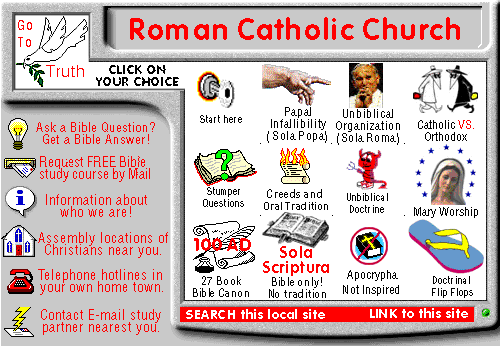|

|
Roman Catholic Faith Examined!
Sign of the cross in its present form, did not exist before 9th century. In about 200AD, the most anyone ever did was sign the cross with their finger on their forehead.
There is absolutely no use of the "sign of the cross" in Apostolic times or the Bible. |

We Speak truth in LOVE
tell us if we have misrepresented Catholic Faith

The Catholic Encyclopedia says: Under "sign of the cross"
"We have positive evidence in the early Fathers that such a practice was familiar to Christians in the second century. "In all our travels and movements", says Tertullian [200AD] (De cor. Mil., iii), "in all our coming in and going out, in putting of our shoes, at the bath, at the table, in lighting our candles, in lying down, in sitting down, whatever employment occupieth us, we mark our foreheads with the sign of the cross"."
"On the whole it seems probable that the ultimate prevalence of the larger cross is due to an instruction of Leo IV in the middle of the ninth century."
"Most commonly and properly the words "sign of the cross" are used of the large cross traced from forehead to breast and from shoulder to shoulder, such as Catholics are taught to make upon themselves when they begin their prayers, and such also as the priest makes at the foot of the altar when he commences Mass with the words: "In nomine Patris et Filii et Spiritus Sancti". (At the beginning of Mass the celebrant makes the sign of the cross by placing his left hand extended under his breast; then raising his right to his forehead, which he touches with the extremities of his fingers, he says: In nomine Patris; then, touching his breast with the same hand, he says: et Filii; touching his left and right shoulders, he says; et Spiritus Sancti; and as he joins his hands again adds: Amen.) The same sign recurs frequently during Mass, e.g. at the words "Adjutorium nostrum in nomine Domini", at the "Indulgentiam" after the Confiteor, etc., as also in the Divine Office, for example at the invocation "Deus in adjutorium nostrum intende", at the beginning of the "Magnificat", the "Benedictus", the "Nunc Dimittis", and on many other occasions." ... "On the whole it seems probable that the ultimate prevalence of the larger cross is due to an instruction of Leo IV in the middle of the ninth century. "Sign the chalice and the host", he wrote, "with a right cross and not with circles or with a varying of the fingers, but with two fingers stretched out and the thumb hidden within them, by which the Trinity is symbolized. Take heed to make this sign rightly, for otherwise you can bless nothing" (see Georgi, "Liturg. Rom. Pont.", III, 37)." (Sign of the cross, The Catholic Encyclopedia, Volume XIII, Copyright © 1912 by Robert Appleton Company)

Go To Start: WWW.BIBLE.CA

